Automating your email marketing strategy effectively requires strategic implementation to uphold quality. Start by employing trigger emails to improve engagement, enhancing conversion rates by up to 8.59%. Maintain a clean and segmented email list to optimize deliverability, as it can lead to a 95% improvement. Use email authentication protocols like SPF and DKIM to secure sender reputation. Segmented campaigns can yield a 760% increase in revenue, highlighting the importance of personalization. Guarantee compliance with regulations such as GDPR to maintain trust. By selecting the right tools and focusing on performance metrics, your automation can generate substantial returns. Discover further insights and boost your strategy efficiently.
Key Takeaways
- Implement email automation with personalized, triggered emails to enhance customer engagement and optimize conversion rates.
- Maintain a clean email list using double opt-in and regular cleaning to improve deliverability and sender reputation.
- Use effective segmentation techniques to tailor content and increase campaign revenue significantly.
- Ensure compliance with regulations like GDPR by obtaining explicit consent and providing opt-out options.
- Leverage A/B testing and analytics tools for continual optimization of email content and performance.
Understanding Email Automation
Email automation, a fundamental element of modern marketing strategies, involves the strategic deployment of emails triggered by specific user interactions, such as sign-ups or cart additions, to deliver timely and relevant communication. This approach utilizes trigger emails to capitalize on behavior-based actions, guaranteeing that the content is both personalized and pertinent to the recipient's needs.
A well-structured email marketing strategy capitalizes on targeted email marketing through automated emails, which are instrumental in improving customer engagement by aligning with individual preferences and behaviors. The integration of customer data allows marketers to craft personalized emails, creating a more engaging experience that resonates with recipients. Research indicates that such personalized communications can boost conversion rates to as high as 8.59%.
Moreover, incorporating multiple triggers in email automation is essential for optimizing user experiences and satisfaction. By leveraging customer data, businesses can implement a multifaceted approach, combining behavior, preference, and time-based triggers, to guarantee relevant content reaches the right audience.
This strategic use of automated emails not only enhances engagement but also greatly improves lead generation and conversion rates, showcasing the efficacy of a robust email marketing strategy. Effective email automation therefore remains an invaluable asset in the marketer's toolkit.
Ensuring Email Deliverability
To guarantee ideal email deliverability in automated marketing strategies, maintaining a clean email list is paramount, as it can enhance deliverability rates by up to 20% through reduced bounce rates.
Implementing strategies to enhance sender reputation, such as monitoring with ISPs and avoiding spammy content, is essential since a strong reputation mitigates the risk of emails being flagged as spam.
Additionally, adopting robust email authentication protocols like SPF and DKIM verifies sender identity, further securing high deliverability rates.
Maintain Clean Email Lists
An effectively maintained email list serves as the backbone of a successful email marketing strategy, ensuring ideal deliverability rates and robust subscriber engagement.
Automation plays a vital role in managing your email list, reducing bounce rates, and enhancing deliverability. By regularly cleaning your email list and removing inactive subscribers, you can improve engagement rates by up to 30%.
This proactive approach not only optimizes your sender reputation but also guarantees your emails reach the intended audience, reducing the chance of being marked as spam.
Maintaining a clean email list involves several strategic steps:
- Implement Double Opt-In: This process confirms subscriber interest, resulting in a 20% reduction in bounce rates by ensuring only engaged subscribers receive your content.
- Monitor Bounce Types: Distinguish between hard and soft bounces to effectively manage your list; hard bounces indicate permanent issues, while soft bounces suggest temporary problems.
- Regular List Cleaning: Routinely remove undeliverable addresses and inactive subscribers to achieve a 95% improvement in deliverability.
Optimize Sender Reputation
Optimizing sender reputation stands as an essential strategy in ensuring email deliverability, directly impacting how Internet Service Providers (ISPs) perceive and handle your emails.
Maintaining a clean email list is paramount; poor list hygiene can lead to high bounce rates, consequently deteriorating your sender reputation. A tarnished reputation can profoundly hinder your deliverability. Utilizing double opt-in methods enhances audience engagement, confirming genuine subscriber interest, which bolsters your sender reputation.
To further safeguard your deliverability, it's important to implement email authentication protocols like SPF and DKIM. These measures secure your emails, ensuring ISPs recognize them as legitimate, thereby supporting a strong sender reputation.
Regularly monitoring your sender reputation with tools like Sender Score is a strategic approach to preemptively address potential deliverability issues before they escalate.
Crafting targeted messages and steering clear of spammy subject lines also play essential roles. Misleading language can trigger spam filters, diverting your emails to spam folders and damaging your reputation.
Effective Segmentation Techniques
In the domain of email marketing, effective segmentation techniques serve as a cornerstone for driving considerable revenue growth, with segmented campaigns boasting a 760% increase in revenue.
Automated email campaigns benefit greatly from segmentation, allowing marketers to deliver targeted messaging that aligns with the specific needs and preferences of different audience groups. By analyzing performance metrics such as open rates and click-through rates, companies can refine their strategies, ensuring personalized follow-ups that enhance customer engagement and retention.
Additionally, segmentation aids in achieving GDPR compliance by ensuring emails are sent only to opted-in recipients, reducing unsubscribe rates and maintaining audience trust.
To maximize the potential of segmentation, consider the following strategies:
- Demographic and Behavioral Segmentation: Tailor content based on factors like age, location, and past interaction history for more relevant messaging.
- Purchase History Segmentation: Enable personalized follow-ups by analyzing customers' previous buying behaviors, thereby increasing engagement.
- A/B Testing: Implement tests across different segments to gauge effectiveness and refine content based on performance data.
Incorporating these techniques into automated email campaigns not only enhances personalization but also aligns with compliance requirements, making it a strategic choice for sustainable growth.
Measuring Campaign Success
Evaluating the success of email marketing campaigns hinges on a robust analysis of key performance indicators (KPIs) that provide an extensive view of campaign effectiveness. Central to measuring campaign success are metrics like open rates, click-through rates (CTR), and conversion rates.
Personalized subject lines are instrumental, boosting open rates by 26% and indicating their effectiveness in capturing attention. High CTRs, which can soar to 30% with relevant content, serve as a barometer for engagement, revealing how well the email content resonates with the audience.
Conversion rates are vital in determining the return on investment (ROI), with email marketing campaigns yielding an impressive average return of $36 for every $1 spent. This metric underscores the importance of converting interest into actionable outcomes.
Meanwhile, monitoring unsubscribe rates is critical; increased rates may signal the necessity for improved targeting or content relevance, ensuring the campaign aligns with audience expectations.
Feedback loops play a significant role in ongoing optimization, allowing marketers to refine strategies by analyzing performance metrics and customer responses.
Staying Compliant With Regulations
To navigate the complex landscape of email marketing regulations, compliance with legal frameworks such as GDPR and CAN-SPAM is not just beneficial but mandatory. Best email marketing practices require businesses to obtain explicit consent from subscribers, guaranteeing that automated email marketing strategies remain effective and legally compliant.
This adherence to regulations is vital for maintaining trust and transparency with your audience.
Key strategic actions include:
- Opt-out options: Providing clear and easy opt-out options in every email not only aligns with legal requirements but also enhances user experience and trust.
- Email authentication: Regularly updating authentication protocols like SPF and DKIM helps maintain a good sender reputation, making sure emails reach inboxes rather than spam folders.
- Monitoring sender reputation: Regularly assess sender reputation scores. A poor reputation can greatly hinder deliverability rates, impacting your campaign's success.
Educating your team on these legal requirements and best practices can be a game-changer.
By fostering a culture of compliance, you can effectively mitigate the risk of penalties and bolster your sender reputation.
In an era where data-driven decisions are paramount, staying informed and adaptable guarantees your automated email marketing strategy is both compliant and competitive.
Crafting Engaging Content
Crafting engaging content is a cornerstone of successful automated email marketing strategies, as personalized subject lines alone can boost open rates by 26%, driving improved audience interaction.
In the domain of email marketing automation, delivering the right message is essential. Emails that incorporate engaging visuals and compelling storytelling achieve 94% higher click-through rates, underscoring the significance of content quality.
To further enhance engagement, a well-placed call to action (CTA) is imperative. Clear and concise CTAs can considerably boost conversion rates, with tailored CTAs improving performance by up to 202%. This strategic placement guarantees that recipients know exactly what action to take next, guiding them seamlessly through the conversion funnel.
A/B testing is another critical element in crafting engaging content. It allows marketers to experiment with different content formats and email designs, optimizing their strategies for maximum impact. With 68% of companies reporting better engagement and improved ROI through testing, it is a practice that should not be overlooked.
Consistency in branding within emails is equally important, as it builds trust and increases customer retention. With 60% of consumers preferring to purchase from recognizable brands, maintaining brand consistency guarantees long-term loyalty.
Selecting Automation Tools
In the domain of email marketing, selecting the right automation tools is a strategic decision that can greatly impact campaign success. The choice of email automation tools should focus on enhancing campaign performance through robust features like segmentation, A/B testing, and advanced analytics.
These features not only improve targeting accuracy but also provide valuable insights into user behavior, enabling data-driven decisions. Integration capabilities are essential for seamless connectivity with existing CRM systems and marketing platforms, streamlining workflows and improving efficiency.
A tool that offers ease of integration guarantees that your marketing efforts are cohesive and well-coordinated across different channels. Additionally, the user experience is paramount; choosing tools with intuitive interfaces facilitates quick onboarding and minimizes learning curves, consequently boosting team productivity.
Key considerations when selecting email automation tools include:
- Scalability: Opt for tools that grow with your business, allowing expansion of email lists and workflows without performance issues.
- Customer Support: Verify the platform provides reliable support and resources for troubleshooting and strategy optimization.
- Robust Features: Prioritize tools that offer advanced functionalities to enhance campaign effectiveness and targeting precision.
Continual Optimization Strategies
As the landscape of email marketing continues to evolve, continual optimization strategies become vital for maintaining competitive advantage and maximizing campaign efficacy. Key to this process is the regular analysis of performance indicators like open rates and click-through rates. By evaluating these metrics, marketers can pinpoint areas for improvement and refine email content to better engage their audience.
Incorporating A/B testing into email marketing strategies allows for the evaluation of different subject lines and content variations, facilitating data-driven decisions that enhance engagement and conversion rates. This iterative process guarantees that campaigns are consistently optimized based on empirical evidence.
Segmentation is another cornerstone of effective email marketing. By tailoring campaigns to specific audience groups, marketers can achieve up to a 760% increase in revenue. Segmentation enables the delivery of personalized content that resonates more deeply with subscribers, thereby enhancing engagement.
Monitoring subscriber behavior and engagement metrics is essential for reengaging inactive users. Automation workflows can be adjusted to send targeted follow-up emails, reducing churn rates while maintaining quality interactions.
Frequently Asked Questions
Can You Automate Email Marketing?
Yes, email marketing can be automated. By leveraging automation tools, email segmentation, and personalized content, businesses can enhance audience engagement. Performance tracking and campaign analytics further optimize workflow efficiency, ensuring strategic insights and improved campaign effectiveness.
How Do I Optimize Email Automation?
To optimize email automation, employ email segmentation strategies, personalized content creation, and A/B testing practices. Compare automation tools for efficacy, implement audience engagement techniques, establish automated response sequences, and utilize performance tracking metrics for continuous improvement.
What Is the Best Method to Keep Your Email Marketing Out of Spam Filters?
To prevent emails from landing in spam filters, employ spam filter techniques, enhance email deliverability through sender reputation management, and utilize content personalization strategies. Leverage list segmentation practices, engagement tracking methods, and unsubscribe prevention tactics for ideal results.
How to Plan an Email Marketing Strategy?
To effectively plan an email marketing strategy, prioritize audience segmentation and content personalization. Implement campaign scheduling and subject line testing, leveraging A/B testing for optimization. Analyze performance metrics to refine engagement strategies and achieve strategic, data-driven insights.
Conclusion
Implementing an automated email marketing strategy necessitates a thorough understanding of automation tools, effective segmentation, and deliverability techniques. Success is measured through careful analysis of campaign metrics, ensuring compliance with relevant regulations, and crafting content that engages recipients. Selection of appropriate tools and continual optimization further enhance performance. By integrating these data-driven and strategic elements, organizations can maintain high-quality email marketing efforts that consistently achieve desired outcomes, thereby maximizing return on investment and fostering sustained audience engagement.




